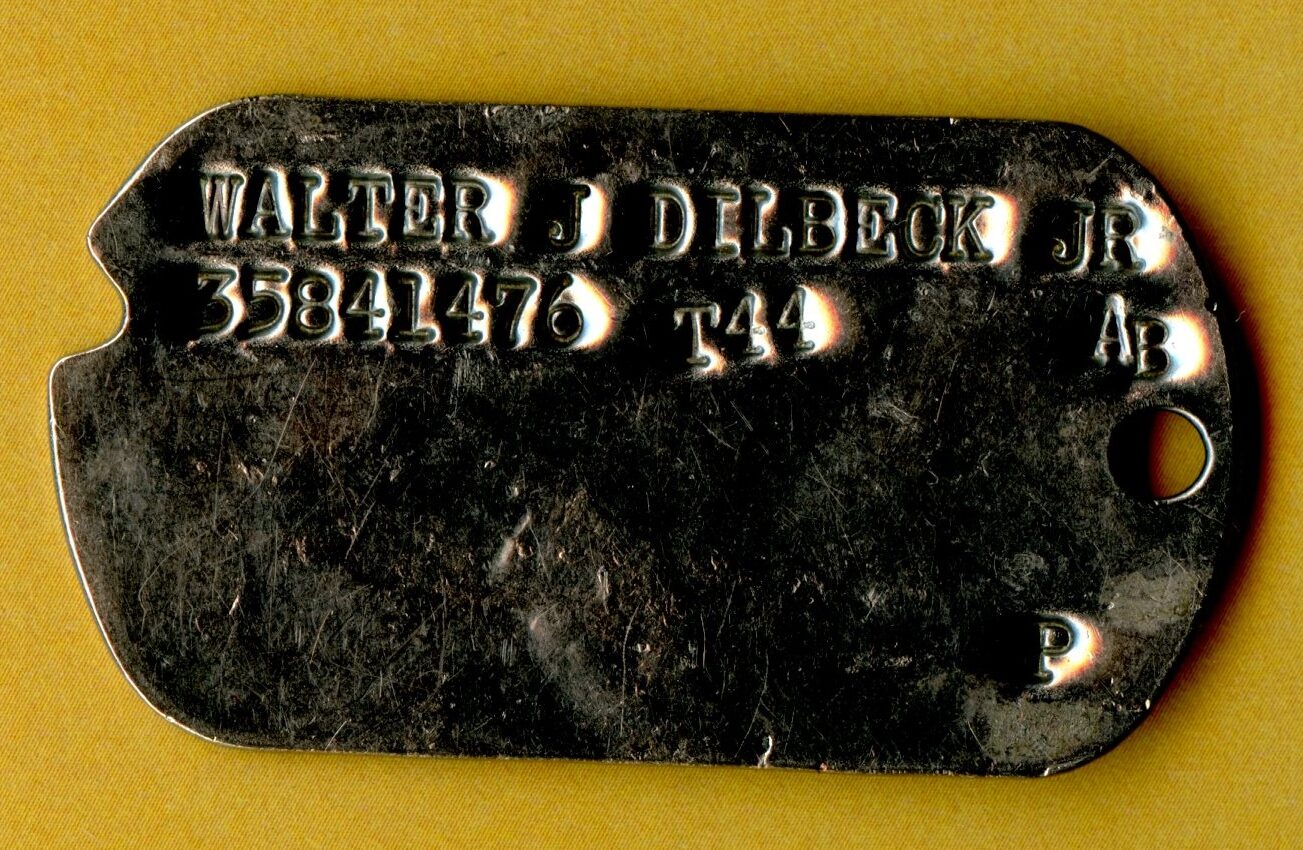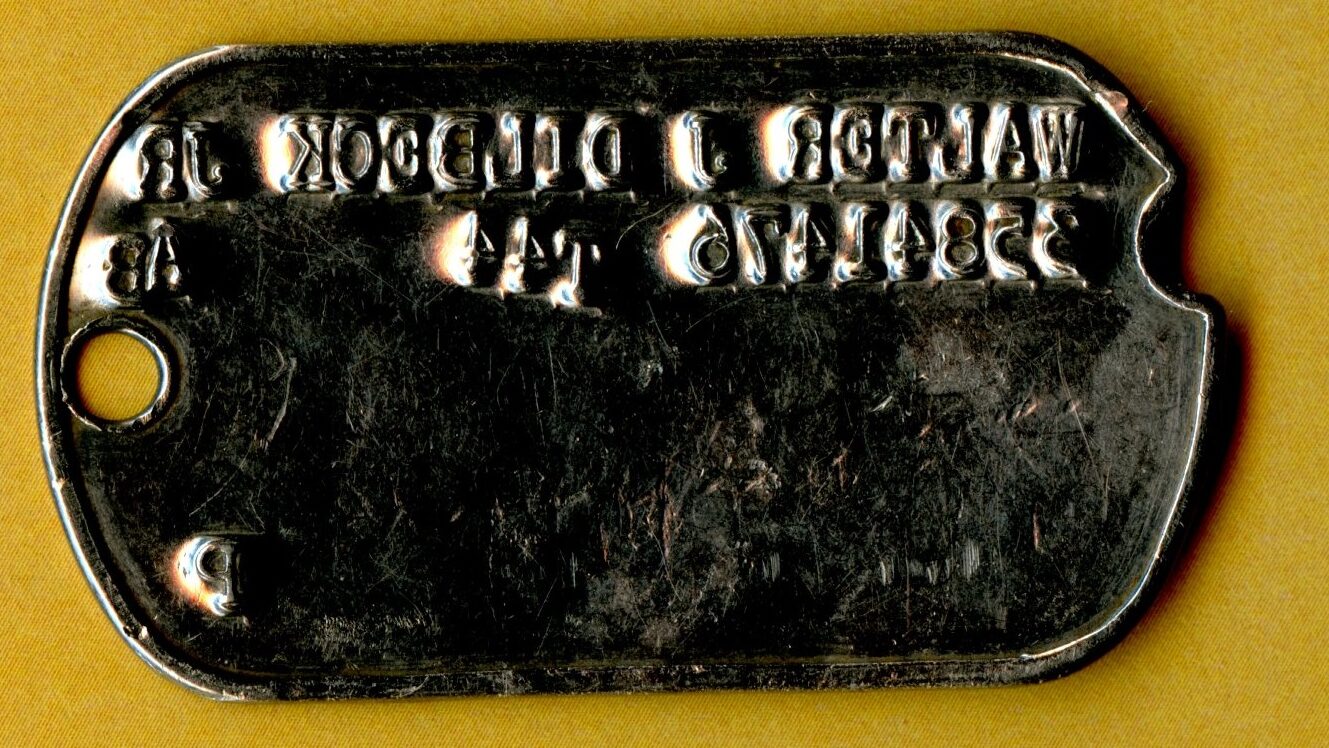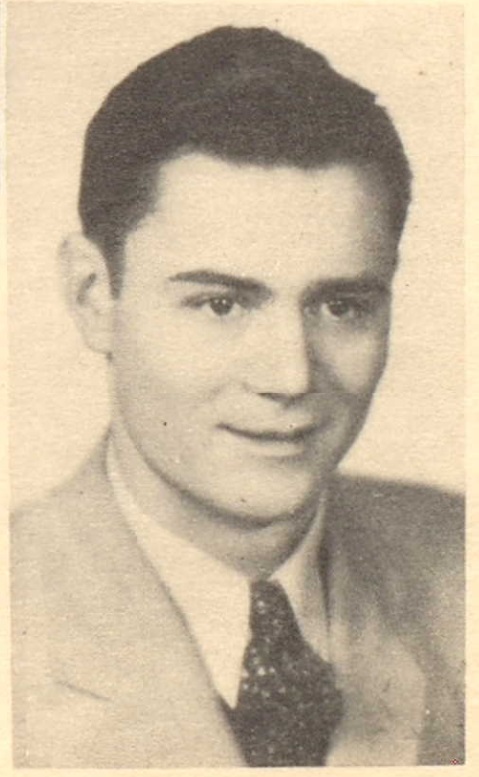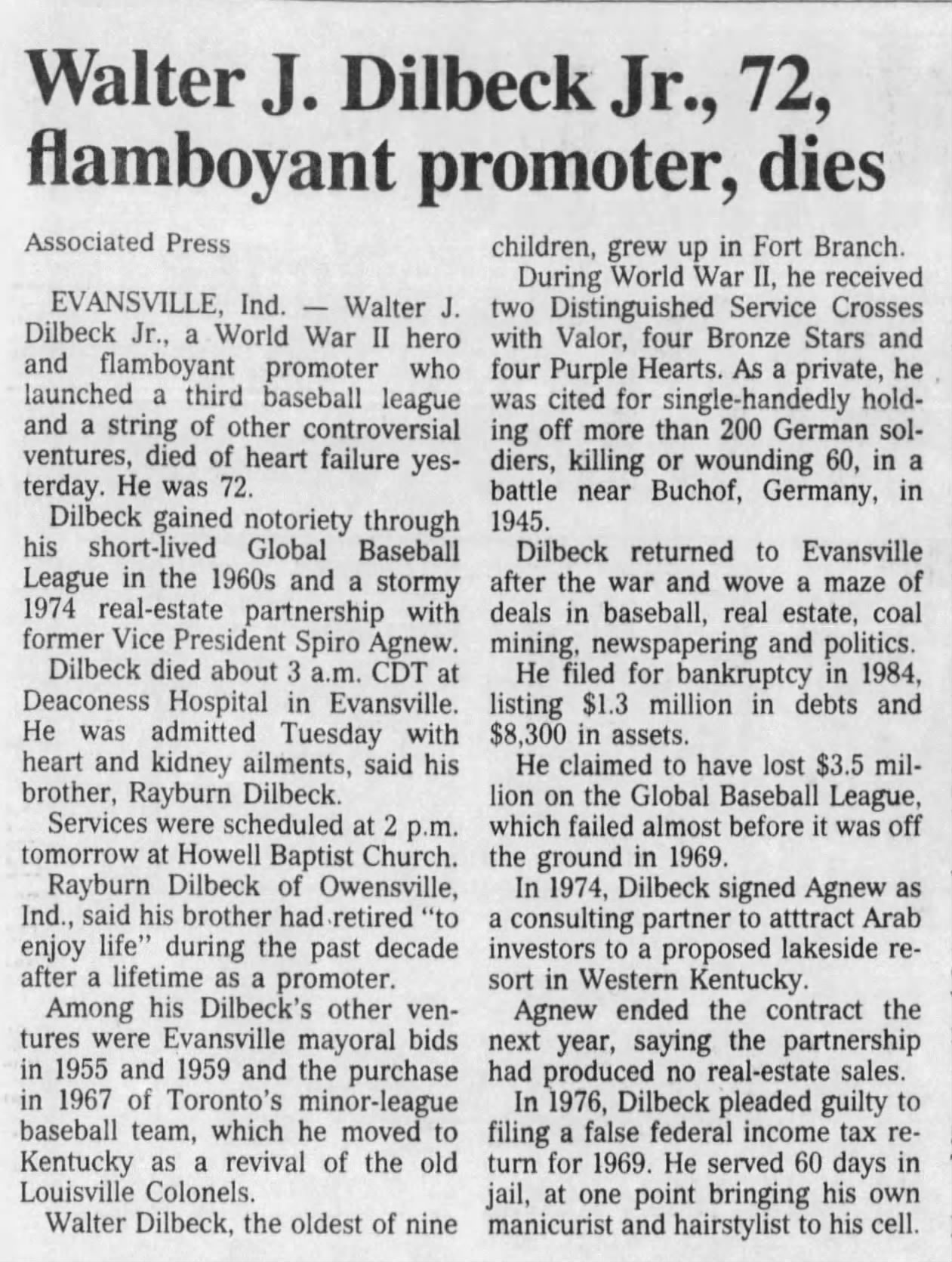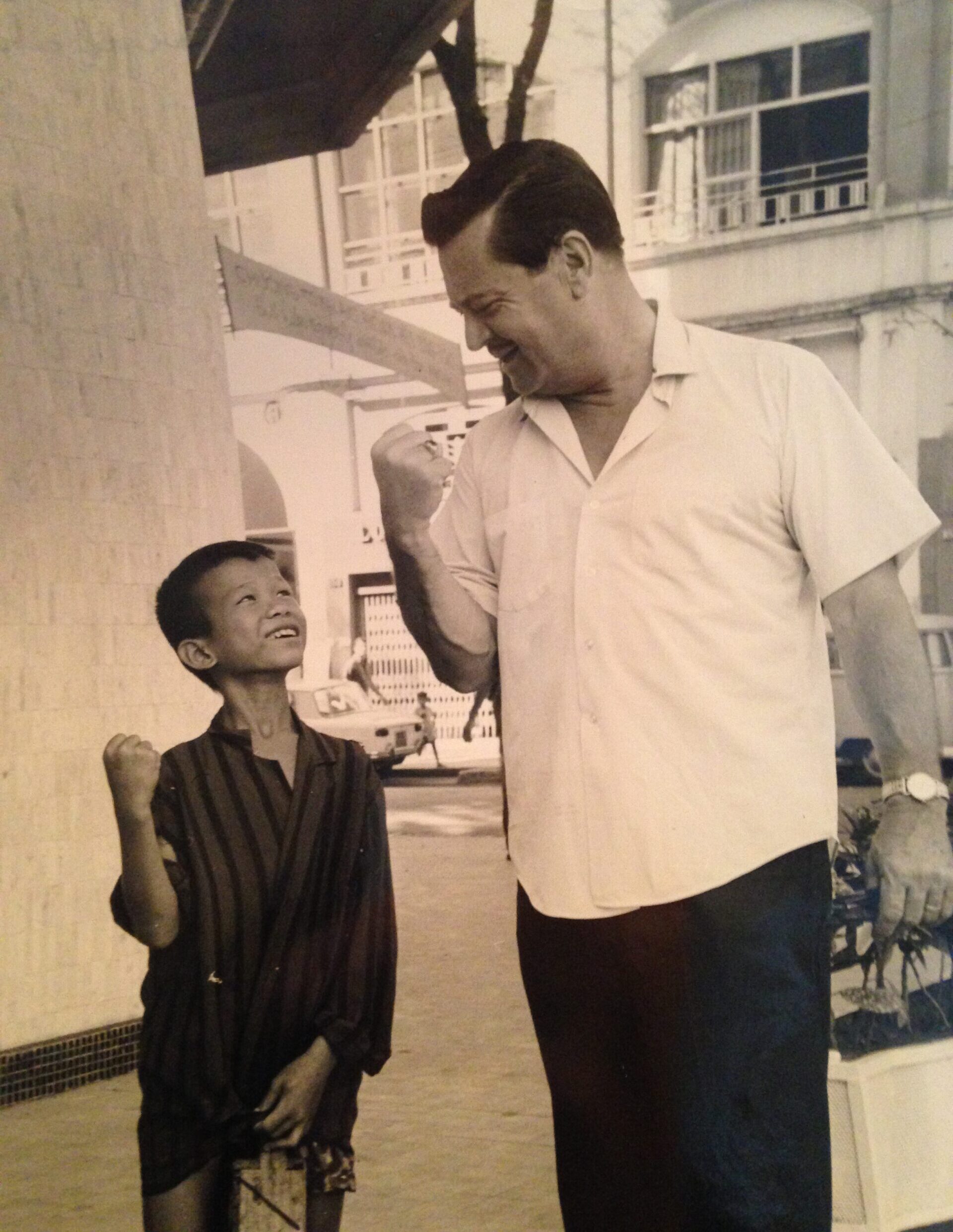PFC Walter James Dilbeck, Jr. 35841476
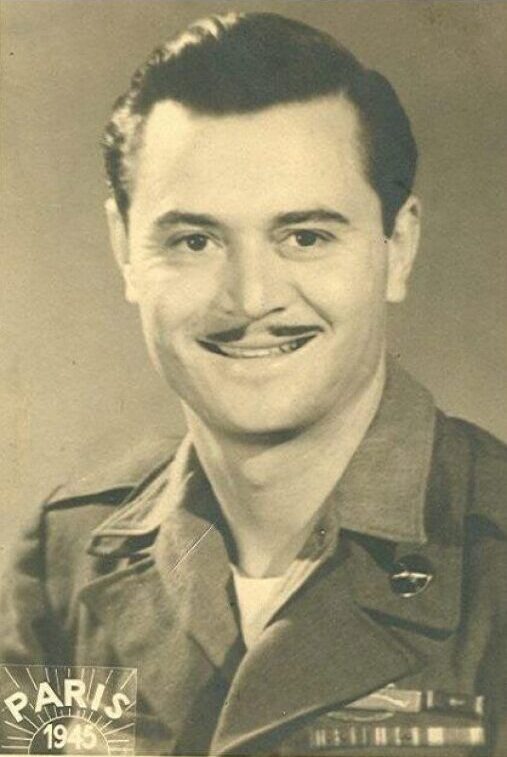
PFC Walter James Dilbeck, Jr. 35841476 US Army DSC. He was born on July 11, 1918 at Camp Funston, in Gardner, Kansas, he was the son of Walter James Dilbeck Sr. and Kathryn Esther Gray Dilbeck. He was the oldest child of 9. In 1920 he was living in Union, Gibson, County Indiana. In 1930 he was living at Fort Branch, in Gibson County, Indiana. He graduated from Fort Branch High School in 1936. At Fort Branch High School he was the Secretary of the History Club and a member of it for 2 years, he also was on the Basketball team for 4 years from 1933 – 1936. He married Dorothy Louise Rogers Dilbeck after High School and they had 4 daughters in their marriage. In 1942 he was living at 70b Adams Ave in Evansville, Indiana, and was working as a Collector and as a minor league baseball player.
He entered the US Army on June 3, 1944 at Fort Benjamin Harrison Indiana, at the age of 25. At the time of his enlistment he was 5 foot 11 inches tall weighed 165 pounds had Brown eyes and Black Hair and had 3 of his 4 daughters. After training in the United States he was shipped overseas and assigned with the 142nd Infantry Recement, 36th Infantry Division. In February, 1945 the 36th Infantry Division asked for 250 volunteers to join the 63rd Infantry Division to add some combat veterans to their ranks. PFC Dilbeck was one of them. On February 21, 1945 he entered, F Company, 253rd Infantry Regiment, 63rd Infantry Division from the 71st Reinforcement Battalion along with; Cpl. Edward Stephen Bezilla Sr. 35288487, Pfc. Thomas E. Brown 32751247, Pfc Hugh J. Burns 37186329, Sgt. Charles E. Dixon 34924565, Pfc Roy U. Doan 35840965, Pfc. Grady Lee Dobson 34973979, PVT Roy Dotson 33821574 KIA, PFC John “Jack” I Douglas 39299432 KIA, PFC Wayne W. Dow 6911009 KIA, PFC. Marvin D. Drumheller 33887019, Pfc Charles E. Duggan 36984170, and T/4 John Zito 39680847. He fought with 1st Squad, 1st Platoon, F Company through the Rhineland Campaign including the 63rd Division’s brake through the Siegfried line. He earned another battle star on his ETO medal for the last campaign of the war Central Europe Campaign which included the taking of Heidelberg Germany, and all the fighting in April 1945. From April 2 to April 12, 1945 the 63rd Infantry Division had the hardest fighting of the war.
On April 4, 1945 F Company crossed the Jagst River. They occupied the town of Untergriesheim until the early morning of April 6, 1945.
April 6 was a very important day for PFC Dilbeck it was one of his daughter’s birthday, he had 3 daughters at this time, and he wore one of each of their babies’ socks around his neck, on his dog tag chain. On this morning the men of F Company awoke at 0600 hours. At 0630 hours they left the shelter of the cellars in the town of Untergriesheim where they had slept. They knew what was awaiting them: another attempt on the hill outside the town and the towns after it. At 0700 hours, the men were in a single file line at the front end of Untergriesheim. Each man received a large piece of chocolate cake while they walked to the hill southwest of the town of Untergriesheim. At this time PFC Bane saw PFC Grover J Dees walking through the gate singing the song Glory Glory Hallelujah, but he changed the words to glory glory what a hell of a way to die he was laughing about it. It took them about 20 minutes to take the hill after that they started advancing to Buchhof. During the one and three-fourths mile advance, the company had to clean out several machine gun and sniper positions while receiving artillery fire. This caused the advance to Buchhof to take about three and a half hours. F Company and G Company arrived at Buchhof at 11:00 and took the town after about an hour of fighting.
At 1230 hours, after clearing the snipers from the town, the two companies spotted a RECON being conducted by the 17th SS the men of F and G Companies believed this to be an attack and referred to this as an counterattack. Once the 63rd Division made contact with the 17th SS, the 17th SS used mortar, artillery, and rocket fire against the American positions at Buchhof. During the fighting at 1230 PFC Walter J. Dilbeck was in his fox hole in front of the Church in the apple orchard. He saw that a building was on fire and inside the building was an 8-year-old girl named Maria Götz. With no regard for his personal safety, and probably thinking of his own daughters PFC Dilbeck ran over and pulled her out of the burning building. He then took her back to his fox hole for her safety. At around 1300 hours PFC Dilbeck told Maria Götz to walk to the American lines and told her which way to go. Maria Götz credits PFC Walter Dilbeck for saving her life on April 6, 1945.
At around 1545 hours the 17th SS Unleashed a large multi-directional attack on F Company. When the German counterattack struck the First Platoon, only a hand full of men stood their ground from 1st Squad led by PFC Walter J. Dilbeck. The remainder of the platoon fell back to the town of Buchhof because they had no commanders to stop them. When F Company retreated to Buchhof, the enemy forces moved “into the foxholes as [quickly] as they were vacated. From this new position, the Germans poured out a deadly stream of automatic and small arms fire,” against F Company, giving them no chance to reorganize. “Realizing that something had to be done to stop the enemy attack, [PFC] Dilbeck stopped voluntarily on a bare knoll and began to pour deadly automatic rifle fire into the ranks of the charging SS troops.” Dilbeck “was trying to keep the front down with his Browning Automatic Rifle (AR) he had 3 ammo bursts” and 2 Men with carbine shooting the left flank.” PFC Dilbeck “got a bullet hole through the leg that broke the bone, which I didn’t know at the time, but it came out sideways. I had 3 babies socks, as I said before, on my dog tags. So I packed some mud into the hole in my leg and I tied a tourniquet right underneath the top of the leg which was tied, and it was very hard to stop the blood. I couldn’t get the blood stopped as my leg was jumping on me. I couldn’t get it quieted down so I could shoot the AR and so I put the AR on this wagon wheel that was close to me.” “In front of me was Grover J. Dees, 19 year old boy from Mobile Alabama. Dees had gotten shot in the stomach and he was standing with a hole in his stomach trying to shoot these bastards down until these boys could line up 300 more rounds of ammunition. The next shot that this boy got was through the mouth, right through the side of his jaw and came out the other side, he was vomiting blood and he was still firing his carbine. This boy should have had the Congressional Medal of Honor if anybody should have ever gotten one. He dropped dead with 2 holes in him, still firing his carbine.” A few minutes after that the Germans were behind Dilbeck in the Apple orchard, there was crossfire happening. “As I turned around, they started firing in the orchard behind me and this German shot me through the back, this went through my canteen through my belt and it felt like I was on fire. I began to see lights, like I’m going to sleep, and I had my AR and I kept thinking Heaven was coming or something, I saw streaks through the sky and everything else. Finally I took a drink and I took some sulfa and I saw the SS troopers they were with in about 60 to 80 feet and they were trying to get to the AR, and we were down to 3 of us left … and 2 of the guys are throwing me 3 magazines and the last kraut I couldn’t get, he kept coming, he was walking straight up with both hands to me, and he was the biggest German I’d ever seen before then or since. He had both hands waving in the air, acting like he was trying to surrender, but he was trying to get the AR. I shot him 5 or 6 times and gave him 2 bursts and that is the last thing that I remember.” Before he passed out due to blood loss over the wagon wheel. Dilback and Dees had killed or wounded over 60 SS troops. Their actions in the apple orchard caused 2nd Battalion of the 38th SS Regiment attack to drawl down and bought Fox Company much needed time.
At 1900 hours, on April 6,1945 B Company of the 253rd Infantry Regiment, 63rd Infantry Division came to Buchhof from Herbolzheim to relive the men of 2nd Battalion and to evacuate the wounded. They found Grover Dees’ and Walter Dilback’s bodies and were surprised to discover that Walter Dilback was still alive and they took him to the 117th Evacuation Hospital.
When PFC Dilback woke up at the hospital he call out to see if there was anyone from F Company in the room and PFC Albert Fernow 35841722 from his squad answered. Fernow did not believe that it was Dilback because he though that Dilback died on the wagon wheel.
Dilback went to many Hospitals but his wounds that day would keep him from ever playing minor league baseball again. He returned to F Company 253rd Infantry and served with them until June 27th 1945 when he was transferred back to the 36th Infantry Division. He then transferred to the 7th Army Headquarters where one of his jobs was guarding German POWs. He was awarded the Distinguished Service Cross, the Bronze Stare Medal, the Purple Heart Medal, The American Theater of operations Medal, The European African Middle Eastern Theater of operations Medal, the World War Two Victory Medal, Army of Occupation Medal, and the Combat Infantry Badge. He died on May 30, 1991, in Evansville, Indiana, at the age of 72, and was buried there.
Sources:
1- The Battle of Buchhof and Stein am Kocher
2- 63rd Division Records
3- Oral History of PFC Walter J. Dilbeck from the 1960s transcript given to author by Dilbeck’s daughter
4- Ausgabe 79 September 2015 Article written by Andi Wahl
5- Oral history with Maria Götz Done by Timothy Malone and Andi Wahl
6- General Orders: Headquarters, Seventh U.S. Army, General Orders No. 92 (1946)
7- the 1920 United States Federal Census
8- the 1930 United States Federal Census
9- the 1940 United States Federal Census
10- Fort Branch High School Fort Branch, Indiana 1936 Yearbook
11- World War II Draft Cards Young Men, 1940-1947
12- Indiana, U.S., Death Certificates, 1899-2011
13- U.S., World War II Hospital Admission Card Files, 1942-1954
14- Honolulu Star-Bulletin Honolulu, Hawaii, – 31 May 1991
15- The Courier-Journal Louisville, Kentucky, – 31 May 1991
16- The Indianapolis News – Indianapolis, Indiana, – 31 May 1991
17- the U.S., City Directories, 1822-1995
